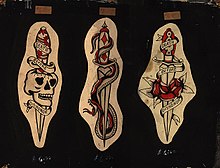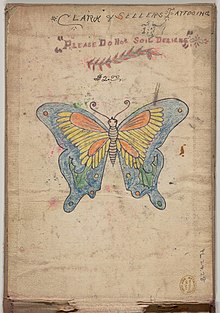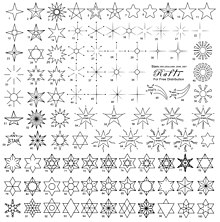Flash (tattoo)

Tattoo flash is any tattoo design that is pre-prepared for customers to avoid the need for custom designs, or as a starting point for custom work. Tattoo flash was designed for rapid tattooing and used in "street shops"—tattoo shops that handle a large volume of standardized tattoos for walk-in customers.[1]: 111 Pieces of flash are traditionally drawn or printed on paper, and displayed for walk-in customers in binders or on the walls of tattoo shops. In the 21st century they may also be advertised online and on social media.
History


The term "flash" is derived from the traveling carnival and circus trade in the late 1800s: an attraction needed to be eye-catching to draw in the crowd, and that visual appeal was called flash.[2] Tattoo artists working at those carnivals would hang up their designs in front of their booths to catch people's attention, so they adopted "flash" as a term for this artwork.[3] Traveling tattoo artists developed sketchbooks of designs that were easy to transport and show to potential customers.[4]
The development of electric tattoo machines in the 1890s enabled faster and more precise tattooing.[5] More tattoo artists started to work from shops as a full-time profession.[4] To fulfill increased demand for tattoos, especially sailor tattoos, artists bought and sold sets of pre-drawn designs.[6] These "flash" designs were on larger sheets of paper than sketchbook pages, intended to be framed and hung on walls.[4] Many of these designs were relatively simple — with black outlines, limited colors, and limited shading — to enable quick work.[6] Skilled professional tattoo artists sold flash to other artists, who were seeking out quality designs to advertise to potential customers.[4] This process of selling and buying attractive sets of designs helped shape American traditional tattooing into a more consistent genre.[4]
Many common flash designs are still in this "old school" style.[7] For example, Lew Alberts (1880–1954), known as Lew the Jew, was a prolific tattoo artist who created and sold many sheets of tattoo patterns.[8] In 2009, a scholar wrote that a large amount of the conventional designs on the walls of contemporary shops were based on designs by Alberts.[1]: 17
In the 1980s there was a shift in iconography from badge-like images based on flash to customized large tattoos influenced by Polynesian and Japanese tattoo art, such as sleeves.[9] By the year 2000, most tattoo studios had become custom shops, with the flash serving largely as a reference for ideas. Most tattoo designs are created by the tattoo artist developing an idea brought in by the customer.
Materials
Flash is either drawn by the individual tattooist for display and use in their own studio,[1]: 101 or traded and sold among other tattooists. Hand-drawn, local tattoo flash has been largely replaced by professional "flash artists" who produce prints of copyrighted flash to sell at conventions or through the Internet.
There is no standard size for tattoo flash, but it is most commonly found on 11x14 inch prints in North America. Tattoo flash may come with an outline, also known as a line drawing, printed on a separate sheet, so that tattoo artists do not need to draw the linework themselves.
References
- ^ a b c Vail, David J.; Sanders, Clinton (2009). Customizing the Body: The Art and Culture of Tattooing. Philadelphia: Temple University Press. ISBN 978-1-59213-888-3.
- ^ Reiter, Jon (2010). These Old Blue Arms, The Life and Work of Amund Dietzel. Solid State Publishing Co. p. 38. ISBN 978-0-578-05967-9. Archived from the original on 2022-04-26. Retrieved 2022-06-19.
- ^ "Vintage Tattoo Flash". Motor City Tattoo Museum. 2018. Retrieved 2022-06-19.
- ^ a b c d e Lane, David C. (2020-11-13). The Other End of the Needle: Continuity and Change Among Tattoo Workers. Rutgers University Press. pp. 16–17. ISBN 978-1-9788-0747-1.
- ^ "Edison and the tattoo". New-York Historical Society. 2011-09-09. Retrieved 2022-06-05.
- ^ a b Festa, Joe (2013-02-06). "A Short, Incomplete History of American Traditional Tattooing". New-York Historical Society. Retrieved 2022-06-05.
- ^ Michalak, Jodie (February 18, 2022). "Flash vs. Custom Tattoos". Byrdie. Retrieved 2022-06-05.
- ^ "Lewis "Lew the Jew" Alberts". Tattoo Archive. 2016. Retrieved 2022-06-05.
- ^ Schildkrout, Enid. "Inscribing The Body." Annual Review of Anthropology 33.1 (2004): 319–44. JSTOR. Web. 28 January 2013.